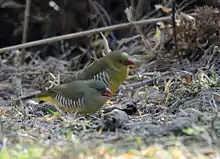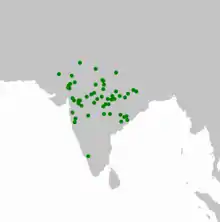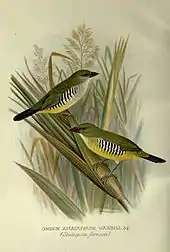Green avadavat
The green avadavat or green munia (Amandava formosa) is a species of Estrildid finch with green and yellow on the body, a bright red bill and black "zebra stripes" on the flanks. They are endemic to the Indian subcontinent and were formerly popular as cagebirds. The name "avadavat" is a corruption of the name the city of Ahmedabad in Gujarat, India, which was a centre of bird trade.[2] They have a restricted distribution and populations are threatened by the bird trade.
| Green avadavat | |
|---|---|
 | |
| A pair at Mt. Abu, India. Female in front. | |
| Scientific classification | |
| Kingdom: | Animalia |
| Phylum: | Chordata |
| Class: | Aves |
| Order: | Passeriformes |
| Family: | Estrildidae |
| Genus: | Amandava |
| Species: | A. formosa |
| Binomial name | |
| Amandava formosa (Latham, 1790) | |
 | |
| Synonyms | |
|
Stictospiza formosa | |
Description

The green avadavat is approximately 10 cm long with green above, yellow below, black and white bars on the flank and reddish bill. Both sexes have pale tips to wing-coverts and tertials. The upper plumage is olive green. The upper tail coverts are more yellow and the tail is black and rounded with broad feathers. The chin is pale yellow and the lower breast, belly and vent are brighter yellow. The flanks are barred with brown and white. The bill is waxy red and the legs are pale fleshy or brown. The female is slightly paler than the male. Young birds are duller with a black bill and lack the barring on the flanks.[3][4]
Distribution
This species is found mainly in the dry scrub regions and agricultural lands and is often found close to water. The largest populations are in central and north-western India. A population of escaped birds once existed near Lahore.[5] The key areas where they are well known are in central India, around southern Rajasthan specifically around Oriya village,[6][7] central Uttar Pradesh, southern Bihar and West Bengal extending south to southern Maharashtra and northern Andhra Pradesh. Some records are from further south from Wynaad in northern Kerala but it is unclear if these are wild populations.[4][8][9]
Behaviour and ecology
They breed in central India from October to January but are also known to breed in July. The nest is made out of broad leaves of grass or sugarcane and is spherical with an entrance on the side. The adaptability for altered habitats is a positive side of its natural survival.[10][11] Several nests may be built in the vicinity by pairs that form a loose colony. They forage in small groups especially in the non-breeding season.[3] The clutch is four to six eggs.[12][13]
Its voice song is high-pitched warble, ending with prolonged trill with weak seee and swee notes not unlike that of Turdoides subrufus.[4][13]
Conservation and community protection
The green avadavat has been a popular cage bird and has been in the bird trade since the late 19th century. It continues to be common in wild areas such as Oriya village, Achalgarh and Guru Shikhar in Mount Abu, Rajasthan, but has declined due mainly to trapping.[14][6][7] In trade the bird is called the green waxbill. Entire flocks are easily trapped using bait and decoy birds.[15] The mass awareness and mobilization towards protection of the habitats at Abu Hills resulted into the positive side.[10] [11][16][17] The awareness level could be well established by the fact that the local administration has used the bird as the Mascot (District Level) for the Indian Parliamentary Election 2019.[11] Similarly, the lost population of Udaipur was also revived to certain extent due to efforts of Department of Forests.[18] However, a study currently being carried out has identified habitat loss as a major threat to the birds, while pointing to a lack of awareness and concrete action to conserve the species among the local community. [14]
References
- BirdLife International (2012). "Amandava formosa". IUCN Red List of Threatened Species. 2012. Retrieved 26 November 2013.CS1 maint: ref=harv (link)
- Yule, Henry; Burnell, A. C. (1903). Crooke, William (ed.). Hobson-Jobson: a glossary of colloquial Anglo-Indian words and phrases, and of kindred terms, etymological, historical, geographical and discursive. London, UK: John Murray.
- Baker, EC Stuart (1926). Fauna of British India. Birds Volume 3 (2nd ed.). Taylor and Francis, London. pp. 94–95.
- Rasmussen PC; JC Anderton (2005). Birds of South Asia: The Ripley Guide. Volume 2. Smithsonian Institution & Lynx Edicions. p. 572.
- Currie,AJ (1916). "The occurrence of the Green Munia Stictospiza formosa at Lahore". J. Bombay Nat. Hist. Soc. 24 (3): 594.
- Mehra, S. & Mehra S. P. (2008). Observations on Green Munia from Abu Hills. Pp. 240-243. In Verma, A. (ed.) Conserving Biodiversity of Rajasthan, Himanshu Publications, Udaipur.
- Mehra, S. P., Mehra S. & Mathur, R. (2005). Munias of Mount Abu (Rajasthan, India) with special emphasis on Green Avadavat Amandava formosa. Indian Birds 1(4): 77-79.
- Santharam,V (2000). "Comments on the bird list of Thattakad Bird Sanctuary, Kerala". J. Bombay Nat. Hist. Soc. 97 (2): 284–285.
- Gaston,AJ; Mackrell,J (1980). "Green Munia Estrilda formosa at Delhi, and other interesting records for 1978". J. Bombay Nat. Hist. Soc. 77 (1): 144–145.
- Mehra, S. (2011). The avifauna of sothen Rajasthan with special emphasis on threatened species and biosacoustic applications in their identification and monitoring. Ph D Thesis, Department of Zoology, Maharshi Dayanand Saraswati University, Ajmer, Rajasthan, India. Pp. viii+248+Appendices 1-6.
- Mehra, S. P. & Mehra, S. (2020) (26 February): Green Munia Amandava formosa https://rajasthanbiodiversity.org/green-muniya/
- Hume, AO (1890). The nests and eggs of Indian birds. Volume 2. RH Porter, London. pp. 145–146.
- Ali S, S DRipley (1999). Handbook of the birds of India and Pakistan. 10 (2nd ed.). Oxford University Press. pp. 108–109.
- Zutshi, S (2020). "Making every chirp count". Deccan Herald.
- Bhargava, Rajat (1996). "Notes on Green Munia". J. Bombay Nat. Hist. Soc. 93 (3): 588–589.
- Mehra, S. P. & Mehra, S. (2020). Socio-Ecological Model for the conservation of species: Case study of Green Munia (Amandava formosa). Udaipur Bird Festival 2020. Pp 19-21.
- Mehra, S. P. & Mehra, S. (2016). Conservation practices for sustainable livelihood - Potential & scope of nature tourism in southern Rajasthan: Case study from Abu Hills. Udaipur Bird Festival 2016. Pp 2.
- Mehra, S. P., Mehra, S. & Sharma, K. K. (2014). Importance of urban biodiversity – A case study of Udaipur, India. Pp. 403-418. In: Maheshwari, B. L., Purohit, R C., Malano, H. M., Singh, V. P. & Amerasinghe (eds.) Securing Water, Food, Energy and the Liveability of Cities: Challenges and Opportunities for Peri-urban Futures, Springer Science+Business Media B.V. Dordrecht, The Netherlands. https://link.springer.com/chapter/10.1007/978-94-017-8878-6_31

